Junctional tachycardia - Study guides, Class notes & Summaries
Looking for the best study guides, study notes and summaries about Junctional tachycardia? On this page you'll find 1077 study documents about Junctional tachycardia.
Page 4 out of 1.077 results
Sort by
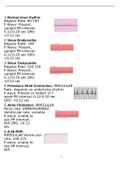
-
Prophecy EKG Questions And Answers 2023/2024
- Exam (elaborations) • 11 pages • 2023
-
- $11.99
- 1x sold
- + learn more
1. Normal sinus rhythm: Regular Rate: 60-100 P Wave: Present, upright PR Interval: 0.12-0.20 sec QRS: <0.12 sec 2. Sinus Bradycardia: Regular Rate: <60 P Wave: Present, upright PR Interval: 0.12-0.20 sec QRS: <0.12 sec 3. Sinus Tachycardia: Regular Rate: 100-150 P Wave: Present, upright PR Interval: 0.12-0.20 sec QRS: <0.12 sec 4. Premature Atrial Contraction: IRREGULAR Rate: depends on underlying rhythm P wave: Present or hidden in T wave PR Interval: 0.12-0.20 sec...
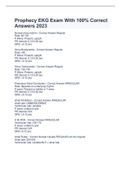
-
Prophecy EKG Exam With 100% Correct Answers 2023
- Exam (elaborations) • 6 pages • 2023
-
Available in package deal
-
- $10.99
- 1x sold
- + learn more
Prophecy EKG Exam With 100% Correct Answers 2023 Normal sinus rhythm - Correct Answer-Regular Rate: 60-100 P Wave: Present, upright PR Interval: 0.12-0.20 sec QRS: <0.12 sec Sinus Bradycardia - Correct Answer-Regular Rate: <60 P Wave: Present, upright PR Interval: 0.12-0.20 sec QRS: <0.12 sec Sinus Tachycardia - Correct Answer-Regular Rate: 100-150 P Wave: Present, upright PR Interval: 0.12-0.20 sec QRS: <0.12 sec Premature Atrial Contraction - Correct Answer-IRREGUL...
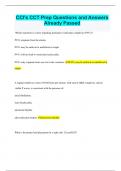
-
CCI's CCT Prep Questions and Answers Already Passed
- Exam (elaborations) • 47 pages • 2024
- Available in package deal
-
- $11.99
- + learn more
CCI's CCT Prep Questions and Answers Already Passed Which statement is correct regarding premature ventricular complexes (PVCs)? PVCs originate from the atrium. PVCs may be unifocal or multifocal in origin. PVCs will not lead to ventricular tachycardia. PVCs only originate from one site in the ventricles. PVCs may be unifocal or multifocal in origin. A regular rhythm at a rate of 40-60 beats per minute, with narrow QRS complexes, and no visible P waves, is consistent with the pre...
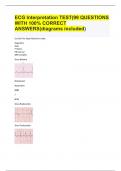
-
ECG Interpretation TEST(99 QUESTIONS WITH 100% CORRECT ANSWERS(diagrams included)
- Exam (elaborations) • 16 pages • 2024
-
Available in package deal
-
- $11.49
- + learn more
List the Five Step Method in order: Regularity Rate P Waves PR Interval QRS Complex Sinus Rhythm Brainpower Read More Previous Play Next Rewind 10 seconds Move forward 10 seconds Unmute 0:07 / 0:15 Full screen Sinus Bradycardia Sinus Tachycardia Sinus Arrhythmia Ventricular Tachycardia Ventricular Fibrillation - Medium Coarse Ventricular Fibrillation - Coarse Ventricular Fibrillation - Fine Asystole Pulseless Electrical Activit...
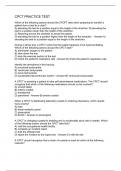
-
CPCT PRACTICE TEST
- Exam (elaborations) • 17 pages • 2024
-
- $12.49
- + learn more
Which of the following actions should the CPCPT take when preparing to transfer a patient from a bed to a chair? A) elevating the bed to a position equal to the height of the stretcher. B) elevating the bed to a position lower than the height of the stretcher. C) Reaching across the stretcher to assist the patient. D) elevating the bed to a position higher than the height of the stretcher. - Answer-A) elevating the bed to a position equal to the height of the stretcher. During a stress ...
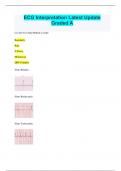
-
ECG Interpretation Latest Update Graded A
- Exam (elaborations) • 21 pages • 2023
- Available in package deal
-
- $9.99
- + learn more
ECG Interpretation Latest Update Graded A List the Five Step Method in order: Regularity Rate P Waves PR Interval QRS Complex Sinus Rhythm Sinus Bradycardia Sinus Tachycardia Sinus Arrhythmia Ventricular Tachycardia Ventricular Fibrillation - Medium Coarse Ventricular Fibrillation - Coarse Ventricular Fibrillation - Fine Asystole Pulseless Electrical Activity (PEA) Torsades de Pointes Atrial Fibrillation Atrial Flutter Premature Atrial Contraction (PAC) Supraventricular Tachycard...
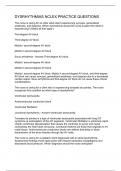
-
DYSRHYTHMIAS NCLEX PRACTICE QUESTIONS AND ANSWERS
- Exam (elaborations) • 10 pages • 2024
-
- $12.49
- + learn more
The nurse is caring for an older adult client experiencing syncope, generalized weakness, and dyspnea. Which dysrhythmia should the nurse suspect the client is experiencing? (Select all that apply.) First-degree AV block Third-degree AV block Mobitz I second-degree AV block Mobitz II second-degree AV block Sinus arrhythmia - Answer-Third-degree AV block Mobitz I second-degree AV block Mobitz II second-degree AV block Mobitz I second-degree AV block, Mobitz II second-degre...
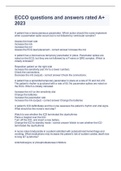
-
ECCO questions and answers rated A+ 2023
- Exam (elaborations) • 45 pages • 2023
-
Available in package deal
-
- $26.49
- 1x sold
- + learn more
ECCO questions and answers rated A+ 2023 A patient has a transcutaneous pacemaker. Which action should the nurse implement when a pacemaker spike occurs but is not followed by ventricular complex? Assess the heart rate Increase the mA Increase the mV Assess the ECG lead placement - correct answer Increase the mA A patient has a transvenous temporary pacemaker in place. Pacemaker spikes are noted on the ECG, but they are not followed by a P wave or QRS complex. Which is initially indica...

-
ECG Strip Interpretation with Certified Solutions
- Exam (elaborations) • 106 pages • 2023
- Available in package deal
-
- $12.99
- + learn more
ECG Strip Interpretation with Certified Solutions Normal PR segment length 0.12 - 0.2 sec 3 - 5 small boxes Normal QRS interval 0.06 - 0.1 sec 1 - 3 small boxes Normal P amplitude & duration < 0.12 sec (3 small boxes) < 0.25 mV (2.5 small boxes) causes of arrhythmias HISDEBS: hypoxia, ischemia/irritability, SNS, drugs, electrolytes, bradycardia, stretch (hypertrophy/enlargement) symptoms of arrhythmias none, "palpitations," light-headedness, syncope, angina, HF, sudden death Arrhy...

-
CCI's CCT prep || very Flawless.
- Exam (elaborations) • 19 pages • 2024
-
Available in package deal
-
- $12.99
- + learn more
Which statement is correct regarding premature ventricular complexes (PVCs)? PVCs originate from the atrium. PVCs may be unifocal or multifocal in origin. PVCs will not lead to ventricular tachycardia. PVCs only originate from one site in the ventricles. correct answers PVCs may be unifocal or multifocal in origin. A regular rhythm at a rate of 40-60 beats per minute, with narrow QRS complexes, and no visible P waves, is consistent with the presence of: atrial fibrillation. sinus bradyc...

That summary you just bought made someone very happy. Also get paid weekly? Sell your study resources on Stuvia! Discover all about earning on Stuvia


